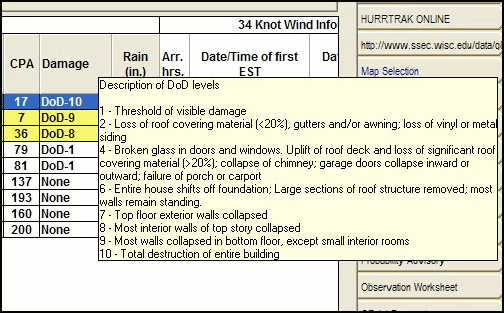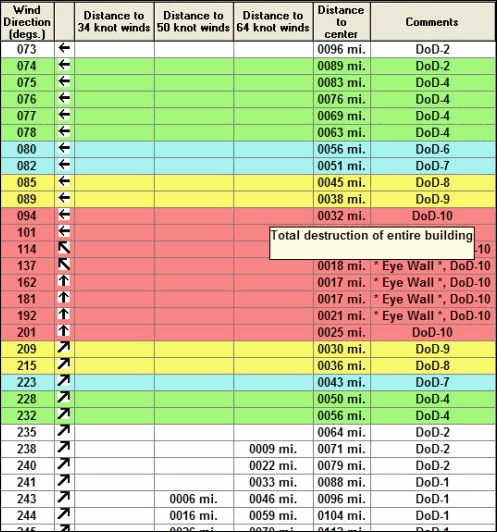
Damage Comments
Prior to 2008, the "Damage" column on the location wind impact reports contained a damage description based on the Saffir-Simpson scale. While certainly a good measure of storm strength, we have found that the Saffir-Simpson scale is not necessarily tailored for damage at individual locations. In 2008 we introduced the ability for the user to choose an alternative scale which is based on observed damage in real situations. This scale is based on work done by the scientists at Texas Tech University and is modified somewhat for hurricanes.
The user can select the damage scale they would like to use via the User Preferences - Report/Impact Analysis option. The option selected will be reflected in the system on all wind impact summary and "hourly" reports.
While viewing a report, the user can display the entire scale by moving the mouse over the DAMAGE header.

Or to see the description of an individual damage level, point the mouse at that value.

The two scales available are shown below:
Saffir Simpson
Scale:
Category One
Hurricane (Sustained
winds 74-95 mph [119-153 km/hr]).
Very dangerous winds
will produce some damage
People, livestock, and pets struck by flying or falling debris could be injured or
killed. Older (mainly pre-1994 construction) mobile homes could be destroyed, especially
if they are not anchored properly as they tend to shift or roll off their foundations.
Newer mobile homes that are anchored properly can sustain damage involving the removal
of shingle or metal roof coverings, and loss of vinyl siding, as well as damage to
carports, sunrooms, or lanais. Some poorly constructed frame homes can experience
major damage, involving loss of the roof covering and damage to gable ends as well
as the removal of porch coverings and awnings. Unprotected windows may break if struck
by flying debris. Masonry chimneys can be toppled. Well-constructed frame homes could
have damage to roof shingles, vinyl siding, soffit panels, and gutters. Failure of
aluminum, screened-in, swimming pool enclosures can occur. Some apartment building
and shopping center roof coverings could be partially removed. Industrial buildings
can lose roofing and siding especially from windward corners, rakes, and eaves. Failures
to overhead doors and unprotected windows will be common. Windows in high-rise buildings
can be broken by flying debris. Falling and broken glass will pose a significant
danger even after the storm. There will be occasional damage to commercial signage,
fences, and canopies. Large branches of trees will snap and shallow rooted trees
can be toppled. Extensive damage to power lines and poles will likely result in power
outages that could last a few to several days. Hurricane Dolly (2008) is an example
of a hurricane that brought Category 1 winds and impacts to South Padre Island, Texas.
Category Two Hurricane
(Sustained winds 96-110 mph [154-177 km/hr]).
Extremely dangerous
winds will cause extensive damage
There is a substantial risk of injury or death to people, livestock, and pets due
to flying and falling debris. Older (mainly pre-1994 construction) mobile homes have
a very high chance of being destroyed and the flying debris generated can shred nearby
mobile homes. Newer mobile homes can also be destroyed. Poorly constructed frame
homes have a high chance of having their roof structures removed especially if they
are not anchored properly. Unprotected windows will have a high probability of being
broken by flying debris. Well-constructed frame homes could sustain major roof and
siding damage. Failure of aluminum, screened-in, swimming pool enclosures will be
common. There will be a substantial percentage of roof and siding damage to apartment
buildings and industrial buildings. Unreinforced masonry walls can collapse. Windows
in high-rise buildings can be broken by flying debris. Falling and broken glass will
pose a significant danger even after the storm. Commercial signage, fences, and canopies
will be damaged and often destroyed. Many shallowly rooted trees will be snapped
or uprooted and block numerous roads. Near-total power loss is expected with outages
that could last from several days to weeks. Potable water could become scarce as
filtration systems begin to fail. Hurricane Frances (2004) is an example of a hurricane
that brought Category 2 winds and impacts to coastal portions of Port St. Lucie,
Florida with Category 1 conditions experienced elsewhere in the city.
Category Three Hurricane
(Sustained winds 111-130 mph [178-209 km/hr]).
Devastating damage
will occur
There is a high risk of injury or death to people, livestock, and pets due to flying
and falling debris. Nearly all older (pre-1994) mobile homes will be destroyed. Most
newer mobile homes will sustain severe damage with potential for complete roof failure
and wall collapse. Poorly constructed frame homes can be destroyed by the removal
of the roof and exterior walls. Unprotected windows will be broken by flying debris.
Well-built frame homes can experience major damage involving the removal of roof
decking and gable ends. There will be a high percentage of roof covering and siding
damage to apartment buildings and industrial buildings. Isolated structural damage
to wood or steel framing can occur. Complete failure of older metal buildings is
possible, and older unreinforced masonry buildings can collapse. Numerous windows
will be blown out of high-rise buildings resulting in falling glass, which will pose
a threat for days to weeks after the storm. Most commercial signage, fences, and
canopies will be destroyed. Many trees will be snapped or uprooted, blocking numerous
roads. Electricity and water will be unavailable for several days to a few weeks
after the storm passes. Hurricane Ivan (2004) is an example of a hurricane that brought
Category 3 winds and impacts to coastal portions of Gulf Shores, Alabama with Category
2 conditions experienced elsewhere in this city.
Category Four Hurricane
(Sustained winds 131-155 mph [210-249 km/hr]).
Catastrophic damage
will occur
There is a very high risk of injury or death to people, livestock, and pets due to
flying and falling debris. Nearly all older (pre-1994) mobile homes will be destroyed.
A high percentage of newer mobile homes also will be destroyed. Poorly constructed
homes can sustain complete collapse of all walls as well as the loss of the roof
structure. Well-built homes also can sustain severe damage with loss of most of the
roof structure and/or some exterior walls. Extensive damage to roof coverings, windows,
and doors will occur. Large amounts of windborne debris will be lofted into the air.
Windborne debris damage will break most unprotected windows and penetrate some protected
windows. There will be a high percentage of structural damage to the top floors of
apartment buildings. Steel frames in older industrial buildings can collapse. There
will be a high percentage of collapse to older unreinforced masonry buildings. Most
windows will be blown out of high-rise buildings resulting in falling glass, which
will pose a threat for days to weeks after the storm. Nearly all commercial signage,
fences, and canopies will be destroyed. Most trees will be snapped or uprooted and
power poles downed. Fallen trees and power poles will isolate residential areas.
Power outages will last for weeks to possibly months. Long-term water shortages will
increase human suffering. Most of the area will be uninhabitable for weeks or months.
Hurricane Charley (2004) is an example of a hurricane that brought Category 4 winds
and impacts to coastal portions of Punta Gorda, Florida with Category 3 conditions
experienced elsewhere in the city.
Category Five Hurricane
(Sustained winds greater than 155 mph [249 km/hr]).
Catastrophic damage
will occur
People, livestock, and pets are at very high risk of injury or death from flying
or falling debris, even if indoors in mobile homes or framed homes. Almost complete
destruction of all mobile homes will occur, regardless of age or construction. A
high percentage of frame homes will be destroyed, with total roof failure and wall
collapse. Extensive damage to roof covers, windows, and doors will occur. Large amounts
of windborne debris will be lofted into the air. Windborne debris damage will occur
to nearly all unprotected windows and many protected windows. Significant damage
to wood roof commercial buildings will occur due to loss of roof sheathing. Complete
collapse of many older metal buildings can occur. Most unreinforced masonry walls
will fail which can lead to the collapse of the buildings. A high percentage of industrial
buildings and low-rise apartment buildings will be destroyed. Nearly all windows
will be blown out of high-rise buildings resulting in falling glass, which will pose
a threat for days to weeks after the storm. Nearly all commercial signage, fences,
and canopies will be destroyed. Nearly all trees will be snapped or uprooted and
power poles downed. Fallen trees and power poles will isolate residential areas.
Power outages will last for weeks to possibly months. Long-term water shortages will
increase human suffering. Most of the area will be uninhabitable for weeks or months.
Hurricane Andrew (1992) is an example of a hurricane that brought Category 5 winds
and impacts to coastal portions of Cutler Ridge, Florida with Category 4 conditions
experienced elsewhere in south Miami-Dade County.
Texas
Tech Study Scale (modified):
|
DOD* |
Damage
description |
|
1 |
Threshold
of visible damage |
|
2 |
Loss
of roof covering material (<20%), gutters and/or awning; loss of vinyl or
metal siding |
|
3 |
Broken
glass in doors and windows |
|
4 |
Uplift
of roof deck and loss of significant roof covering material (>20%); collapse
of chimney; garage doors collapse inward; failure of porch or carport |
|
5 |
Entire
house shifts off foundation |
|
6 |
Large
sections of roof structure removed; most walls remain standing |
|
7 |
Exterior
walls collapsed |
|
8 |
Most
walls collapsed, except small interior rooms |
|
9 |
All
walls |
|
10 |
Destruction
of engineered and/or well constructed residence; slab swept clean |
More information on the Texas Tech Study can be found at http://www.wind.ttu.edu/EFScale.pdf. Again, we use a modified version of this to account for hurricanes.